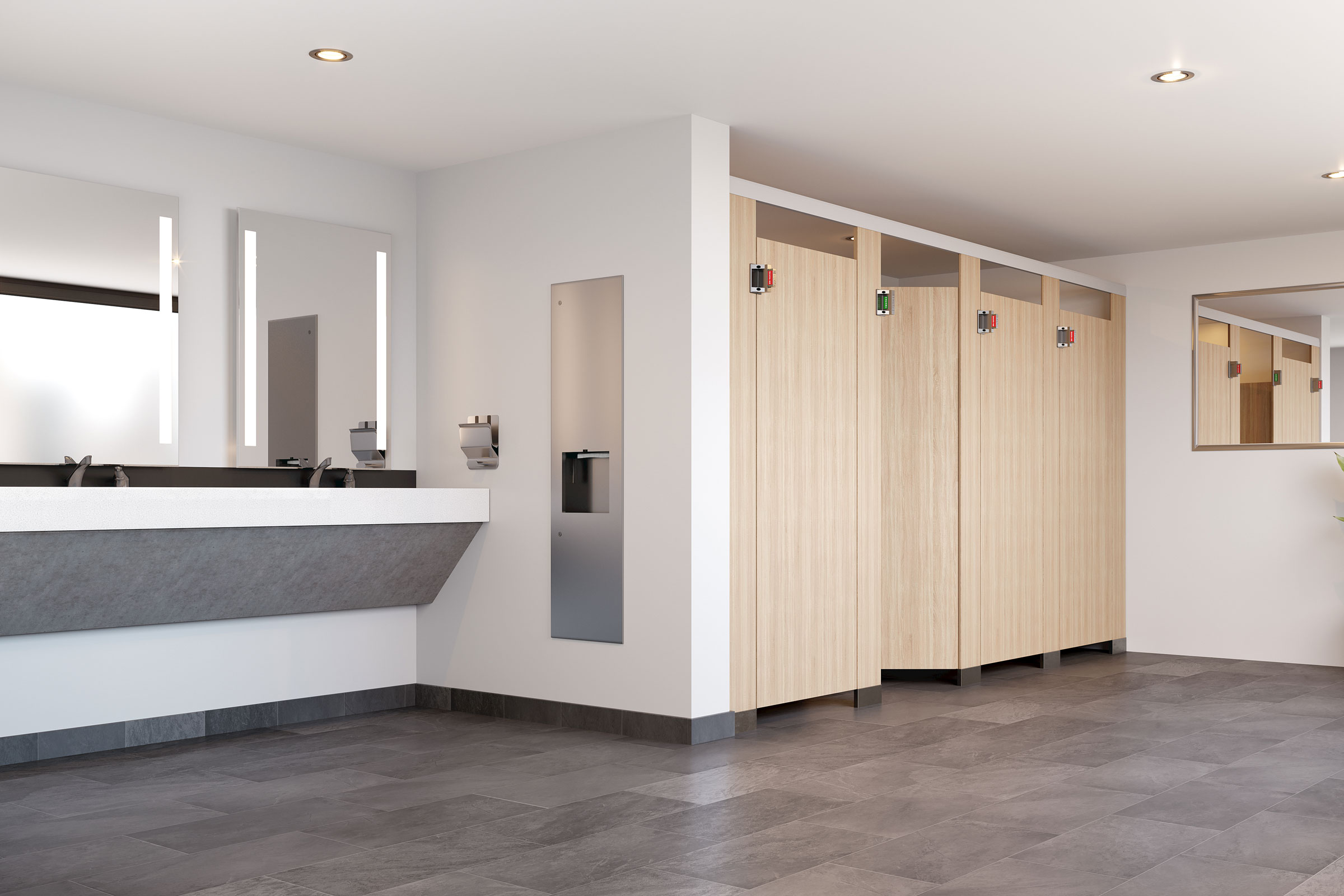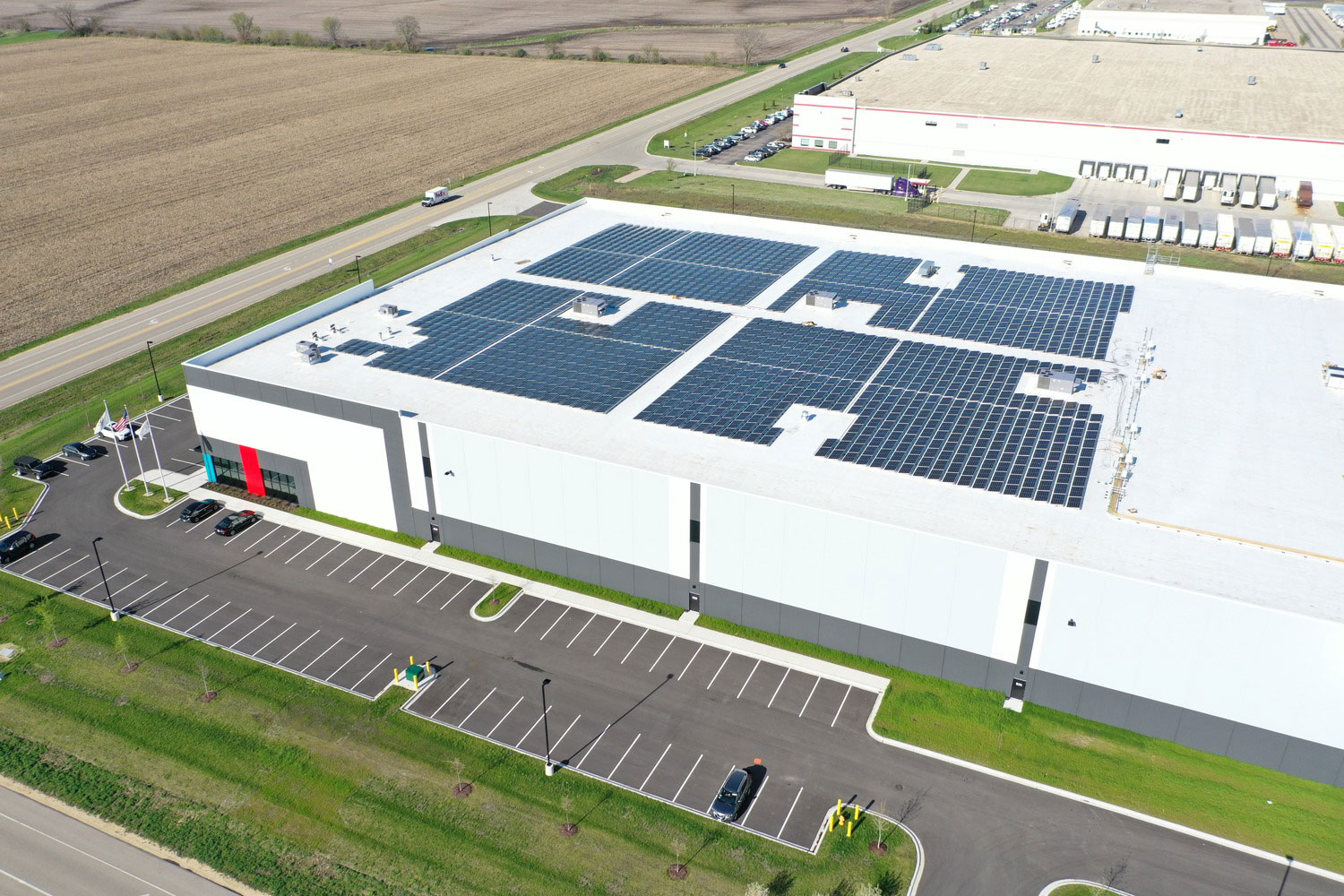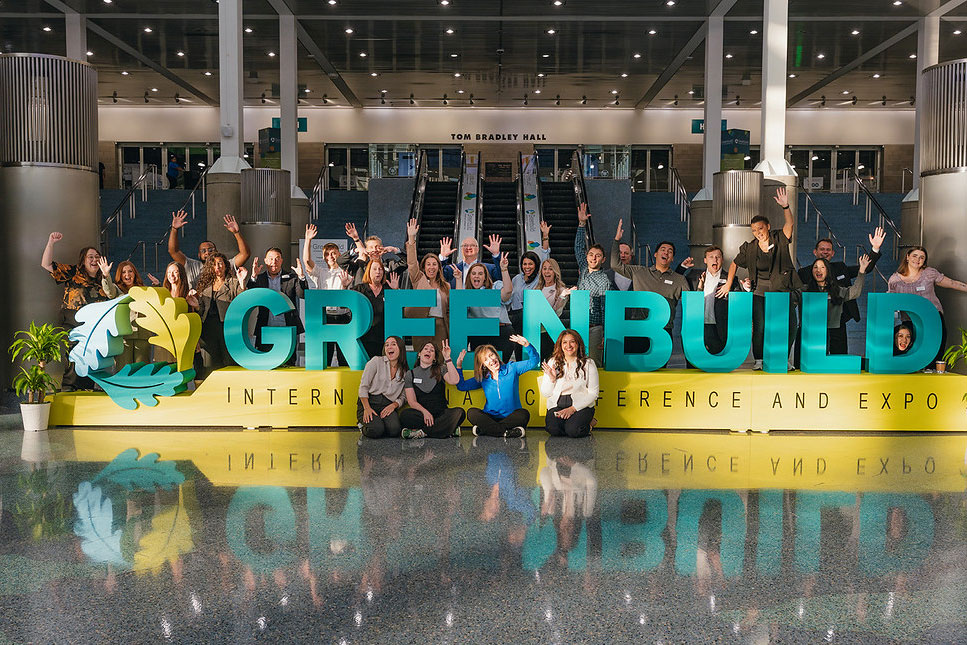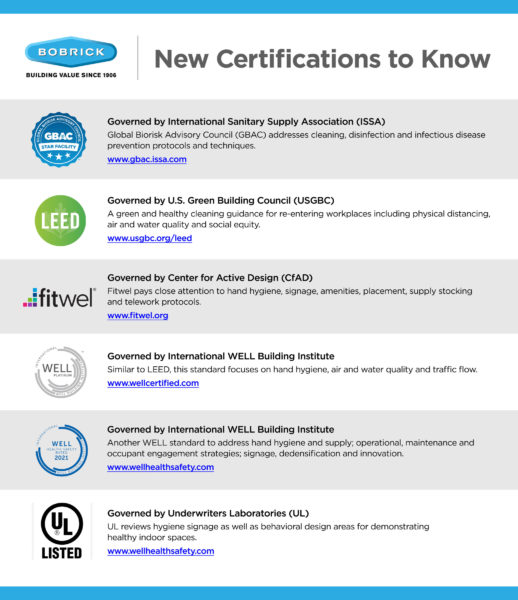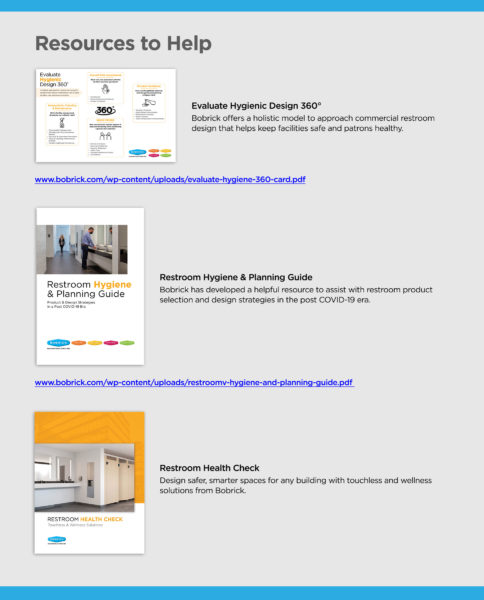As Covid restrictions are lifted and buildings experience higher occupancy levels, designers of commercial buildings must consider the heightened sensitivity of patrons, tenants, and employees toward hygiene and general wellness.
Many might agree that our collective pandemic experience has unfolded in phases since March 2020. In the commercial building world, we’ve recently experienced two phases and will soon see a third. Looking back, what have we learned so far? And how can we use those insights to prepare for post-pandemic hygiene and the future of building?
Phase 1: Lessons Learned from the Reopening Phase

GBAC STAR takes into consideration design spaces and traffic flow to accommodate physical distancing. Photo courtesy of of Bobrick Washroom Equipment, Inc.
Phase one, or the reopening phase that began earlier this year, taught us that most building owners were unprepared for a rigorous inspection of policies and procedures to assure their building could operate hygienically during an outbreak. Additionally, most building designs failed to accommodate safe social distancing, which required the enforcement of new procedures to encourage safer hygienic practices.
Phase 2: What We’re Learning in the Reoccupying Phase
The reoccupying phase marks our present day, where we’re seeing new demands to accommodate lower occupancy, hybrid work schedules, and the need for greater technology. Yet there is still an underlying need to reassure occupants that their health and wellness is a top priority as they return to work.
In a recent survey conducted by Bobrick Washroom Equipment, architects and facility managers were asked about the number one issue they now face. The answer? Hygiene. In fact, 92% of facility managers and 70% of architects said hygiene is “extremely important,” especially in hallways and restrooms.
Design with a Healthy End in Mind
These pandemic lessons are invaluable for designers and architects working on projects today; however, there is a general low level of awareness of new and existing standards that help ensure occupant safety and hygiene over the life of the building.
Architects can and should use these standards as a roadmap for their product selection and space considerations. These new standards help create a common language when reoccupying a building, operating that space, and, ultimately, reassuring the tenants as they return to work. Planning new buildings “with the end in mind” will distinguish projects not only as greener but also more hygienic and safer.
Emerging Hygiene Standards, Certifications, and Expectations
- Courtesy of Bobrick Washroom Equipment, Inc.
Although LEED standards are well known and understood today, architects, designers, and contractors should become familiar with new standards developed by Global Biorisk Advisory Council (GBAC), WELL, Fitwel and UL. These new standards have been implemented to help architects and building management operators design and maintain buildings that are safe and healthy for the occupants and the long-term life of the building.
Some of these standards focus more on facility maintenance procedures, such as GBAC STAR, governed by the International Sanitary Supply Association (ISSA). Meeting this standard may require architects to pay close attention to the availability of the consumables that will be used, such as hand sanitizer and disinfectants. Other standards, such as WELL Building Standard and UL Verified, pay closer attention to encouraging healthy hygiene behaviors through design choices.
It is important to note some key differences among these new standards. Some certifications are evidence-based while others are not. Some focus more on treatment of surfaces while others focus heavily on air and water. Some are very strict while others offer variability in achieving the credential.
Although architects should not be expected to research all relevant requirements across these standards on the front-end of a project, it may be helpful to start a dialogue with clients to understand how the new guidelines may impact the interior spaces, including the overall restroom layout, restroom accessories, toilet compartments, urinals, and janitor’s closets specified based on building occupants’ and facility management’s requirements.
For example, will the emphasis on more frequent cleaning require additional janitor’s closets? Does the janitor’s closet need to be located close to the restroom or even in the restroom? Do they require additional storage capacity and amenities like access to water, a sink, and a floor drain?
Applying These Standards to Four Focus Areas
While these standards may address different areas and design strategies throughout buildings, they all strive to improve the safety profile of the built environment through the mitigation of infectious disease transmission. In many cases, they address common infection prevention strategies that are measurable and repeatable and can be applied to any building type.
Overall, there are four key themes for architects, designers and contractors to keep in mind: hand hygiene, including hand sanitization, handwashing, and hand drying; physical distancing; cleaning and disinfecting; and air and water quality.
1. Hand hygiene

It is important to use counter-mounted soap dispensers to minimize water and soap trails on the counter. Soap dispensers should be touchless and easy to refill. Dispensers that can be top-filled are easier for maintenance teams to maintain, which helps to ensure reliability. Courtesy of of Bobrick Washroom Equipment, Inc.
When meeting restroom requirements such as sealed dispensers, disposable soap cartridges, and hand drying methods, some new standards will require new technology. For instance, WELL Certified offers points specifically for touchless soap dispensers as well as hands-free flushing, faucets, and hand drying.
There are several touchless product solutions to accommodate these new certifications. For sinks, consider installing touch-free, sensor-activated faucets. Bobrick offers touch-free, automatic foam and liquid soap dispensers that can be top filled with nonproprietary soap to make ongoing maintenance quick, simple, and cost-effective.
For hand drying, consider providing both paper towel dispensers with built-in waste receptacle units and automatic hand dryers. For efficiency and where space is limited, look for units that combine a paper towel dispenser with an automatic hand dryer and waste bin to provide patrons with both options in one accessory. Bobrick offers several combination units for Class-A office buildings to fine restaurants.
Ultimately, the goal is to reduce as many touchpoints as possible throughout the restroom space.
2. Physical distancing
According to the CDC, physical distancing, or “social distancing,” means keeping a safe space between yourself and other people who are not from your household as a way to reduce the spread of Covid-19.
While different standards place different emphasis on its importance, several incentivize restrooms that facilitate safe distancing in various ways. GBAC STAR takes into consideration design spaces and traffic flow to accommodate physical distancing. To help eliminate touchpoints, entrances and exits should be laid out to minimize congestion and for universal access. This can be achieved by removing doors to provide hands-free access.
Another tip we often recommend to designers to help maximize the physical barrier between users is to increase toilet compartment panels, doors, and urinal screens to a minimum of 84 inches high and extend them to within 3 inches of the floor.
Other standards are beginning to address hybrid models. Fitwel Viral Response offers recommendations to support remote work, flexible sick leave, and staggered schedules. If clients will have these policies in place, this may impact restroom capacity, the queuing strategy and possibly more. LEED Operations & Management Safety First also has a requirement on re-entering workspaces and social distancing.
Lastly, signage promoting safe distancing will help earn credits under certain standards.
3. Cleaning and disinfecting
Adhering to certain health and wellness standards may require specific restroom amenities and layout strategies. For example, GBAC STAR offers prescriptive, evidence-based requirements for cleaning and disinfecting processes and programs. A cleaning and disinfecting program can have a significant influence on space design, stocking areas and more. Fitwel Viral Response reviews cleaning practices and the required use of EPA-approved disinfectants.
Consider placement of amenities as well. For example, counter-mounted soap dispensers will help minimize water and soap trails on the counter. Designers should also aim to place towel and waste units as close as possible to lavatory and countertop-mounted soap dispensers to eliminate unsanitary, unsafe water trails on floors.
As facilities are required to spend more time sanitizing and disinfecting all parts of the building, it becomes even more important to minimize cleanup and maintenance wherever possible. Thoughtful placement of accessories can help ease the burden.
A new solution to address some of these areas is antimicrobial copper, one of the most effective touch surface materials that kills greater than 99.9% of bacteria. Several independent studies, including a report from Purdue University, have reported antimicrobial efficacy of uncoated copper and copper alloy surfaces against human pathogens, including one strain of coronavirus. Architects might consider installing copper door handles and latches to address this standard.
4. Air and water quality
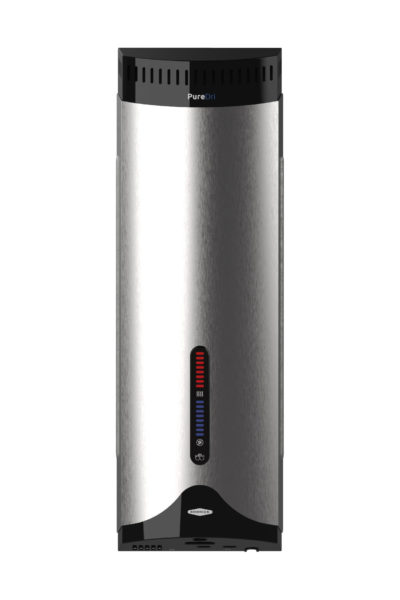
New technologies combine the functionality of a fast-dry hand dryer with photocatalytic disinfection. This technology can kill 98.11% of airborne and 99.6% of surface micro-organisms. Courtesy of of Bobrick Washroom Equipment, Inc.
Both air and water quality are commonly mentioned in health and wellness certification criteria. Standards may have requirements or make recommendations regarding quality, humidity and ventilation. For example, UL standards recommend reducing amplification of airborne microbes. Other standards may recommend maintaining a certain humidity level or flushing of air. WELL Certified also incentivizes certain particle filtration and filter maintenance criteria to address air filtration and treatment systems. Finally, air and water quality monitoring, such as monitoring particulate matter and radon in the air, may require the installation of indoor air monitors.
Designers can combine hand and air sanitation with one machine. New technologies combine the functionality of a fast-dry hand dryer with photocatalytic disinfection. Immediately after the 12-second hand-dry, sanitized air is emitted into a 6-foot area around each hand dryer. Not only does this process ensure the restroom is continuously disinfected, but it also provides triple action defense against the spread of odors, bacteria, and viruses in restrooms, killing 98.11% of airborne and 99.6% of surface micro-organisms.
Phase 3: How to Prepare for the Reimagining Phase
These are not new concepts, but post-pandemic hygiene has amplified their importance and will most likely remain part of the architect’s design challenge for generations.
Although we haven’t stopped the spread of Covid, we’re learning how to protect ourselves from it, and soon we’ll enter the reimagining phase. In this phase, designers and architects will need to incorporate the latest technology and emerging solutions to satisfy these new post-pandemic hygiene, health, and wellness standards. We’ll also need to address three new concerns:
Crowd density
As occupancy levels continue to rise, physical distancing will continue to be a challenge. Smart technology that reports consumable usage and general traffic information will become a valuable facility information system.
Cleanliness
With more traffic, infection prevention processes and protocols centered around effective cleaning and disinfecting will need to evolve.
Promoting good hygiene
As people begin to feel safer, pre-pandemic habits may return, so friendly reminders through signage will continue to be necessary.
As new developments unfold, it’s important for our industry to continue to audit and monitor existing and future projects. For example, an overall risk assessment that encompasses a 360-degree evaluation of the targeted space is one way to ensure constant evaluation. In addition to the four areas mentioned above, these evaluations should take into consideration product selection, space design and cleaning and maintenance. Consultants such as Allynt Solutions are invaluable partners in conducting thorough facility assessments with the new guidelines in mind.
Designers and architects have always been challenged to address new initiatives, and post-pandemic hygiene is no exception. With the pandemic almost in our rearview mirror, the need for hygiene and general wellness will remain a key consideration for years to come.
- Courtesy of Bobrick Washroom Equipment, Inc.

